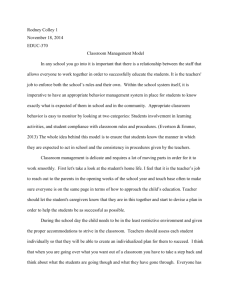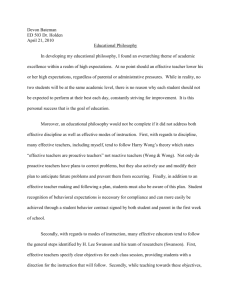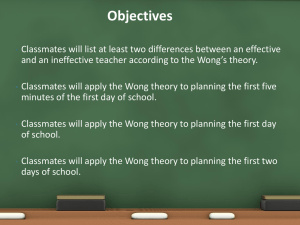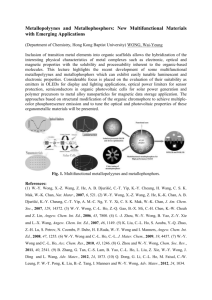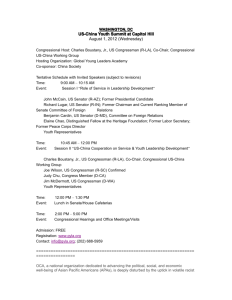Asia Headlines
advertisement
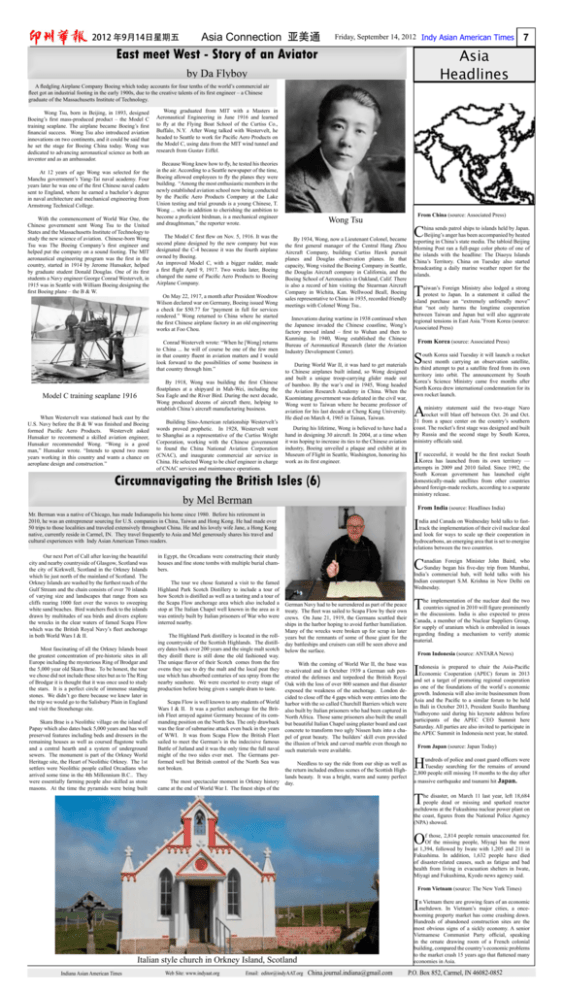
2012 年9月14日星期五 Asia Connection 亚美通 Friday, September 14, 2012 Indy Asian American Times Asia Headlines A fledgling Airplane Company Boeing which today accounts for four tenths of the world’s commercial air fleet got an industrial footing in the early 1900s, due to the creative talents of its first engineer – a Chinese graduate of the Massachusetts Institute of Technology. Wong Tsu, born in Beijing, in 1893, designed Boeing’s first mass-produced product – the Model C training seaplane. The airplane became Boeing’s first financial success. Wong Tsu also introduced aviation innovations on two continents, and it could be said that he set the stage for Boeing China today. Wong was dedicated to advancing aeronautical science as both an inventor and as an ambassador. At 12 years of age Wong was selected for the Manchu government’s Yang-Tai naval academy. Four years later he was one of the first Chinese naval cadets sent to England, where he earned a bachelor’s degree in naval architecture and mechanical engineering from Armstrong Technical College. With the commencement of World War One, the Chinese government sent Wong Tsu to the United States and the Massachusetts Institute of Technology to study the new science of aviation. Chinese-born Wong Tsu was The Boeing Company’s first engineer and helped put the company on a sound footing. The MIT aeronautical engineering program was the first in the country, started in 1914 by Jerome Hunsaker, helped by graduate student Donald Douglas. One of its first students a Navy engineer George Conrad Westervelt, in 1915 was in Seattle with William Boeing designing the first Boeing plane – the B & W. Wong graduated from MIT with a Masters in Aeronautical Engineering in June 1916 and learned to fly at the Flying Boat School of the Curtiss Co., Buffalo, N.Y. After Wong talked with Westervelt, he headed to Seattle to work for Pacific Aero Products on the Model C, using data from the MIT wind tunnel and research from Gustav Eiffel. Because Wong knew how to fly, he tested his theories in the air. According to a Seattle newspaper of the time, Boeing allowed employees to fly the planes they were building. “Among the most enthusiastic members in the newly established aviation school now being conducted by the Pacific Aero Products Company at the Lake Union testing and trial grounds is a young Chinese, T. Wong ... who in addition to cherishing the ambition to become a proficient birdman, is a mechanical engineer and draughtsman,” the reporter wrote. The Model C first flew on Nov. 5, 1916. It was the second plane designed by the new company but was designated the C-4 because it was the fourth airplane owned by Boeing. An improved Model C, with a bigger rudder, made a first flight April 9, 1917. Two weeks later, Boeing changed the name of Pacific Aero Products to Boeing Airplane Company. On May 22, 1917, a month after President Woodrow Wilson declared war on Germany, Boeing issued Wong a check for $50.77 for “payment in full for services rendered.” Wong returned to China where he started the first Chinese airplane factory in an old engineering works at Foo Chou. Conrad Westervelt wrote: “When he [Wong] returns to China ... he will of course be one of the few men in that country fluent in aviation matters and I would look forward to the possibilities of some business in that country through him.” By 1918, Wong was building the first Chinese floatplanes at a shipyard in Mah-Wei, including the Sea Eagle and the River Bird. During the next decade, Wong produced dozens of aircraft there, helping to establish China’s aircraft manufacturing business. Model C training seaplane 1916 When Westervelt was stationed back east by the U.S. Navy before the B & W was finished and Boeing formed Pacific Aero Products. Westervelt asked Hunsaker to recommend a skilled aviation engineer, Hunsaker recommended Wong. “Wong is a good man,” Hunsaker wrote. “Intends to spend two more years working in this country and wants a chance on aeroplane design and construction.” 7 Building Sino-American relationship Westervelt’s words proved prophetic. In 1928, Westervelt went to Shanghai as a representative of the Curtiss Wright Corporation, working with the Chinese government to found the China National Aviation Corporation (CNAC), and inaugurate commercial air service in China. He selected Wong to be chief engineer in charge of CNAC services and maintenance operations. Wong Tsu By 1934, Wong, now a Lieutenant Colonel, became the first general manager of the Central Hang Zhou Aircraft Company, building Curtiss Hawk pursuit planes and Douglas observation planes. In that capacity, Wong visited the Boeing Company in Seattle, the Douglas Aircraft company in California, and the Boeing School of Aeronautics in Oakland, Calif. There is also a record of him visiting the Stearman Aircraft Company in Wichita, Kan. Wellwood Beall, Boeing sales representative to China in 1935, recorded friendly meetings with Colonel Wong Tsu.. Innovations during wartime in 1938 continued when the Japanese invaded the Chinese coastline, Wong’s factory moved inland – first to Wuhan and then to Kunming. In 1940, Wong established the Chinese Bureau of Aeronautical Research (later the Aviation Industry Development Center). During World War II, it was hard to get materials to Chinese airplanes built inland, so Wong designed and built a unique troop-carrying glider made out of bamboo. By the war’s end in 1945, Wong headed the Aviation Research Academy in China. When the Kuomintang government was defeated in the civil war, Wong went to Taiwan where he became professor of aviation for his last decade at Cheng Kung University. He died on March 4, 1965 in Tainan, Taiwan. During his lifetime, Wong is believed to have had a hand in designing 30 aircraft. In 2004, at a time when it was hoping to increase its ties to the Chinese aviation industry, Boeing unveiled a plaque and exhibit at its Museum of Flight in Seattle, Washington, honoring his work as its first engineer. From China (source: Associated Press) C hina sends patrol ships to islands held by Japan. Beijing’s anger has been accompanied by heated reporting in China’s state media. The tabloid Beijing Morning Post ran a full-page color photo of one of the islands with the headline: The Diaoyu Islands China’s Territory. China on Tuesday also started broadcasting a daily marine weather report for the islands. T aiwan’s Foreign Ministry also lodged a strong protest to Japan. In a statement it called the island purchase an “extremely unfriendly move” that “not only harms the longtime cooperation between Taiwan and Japan but will also aggravate regional tensions in East Asia.”From Korea (source: Associated Press) From Korea (source: Associated Press) S outh Korea said Tuesday it will launch a rocket next month carrying an observation satellite, its third attempt to put a satellite fired from its own territory into orbit. The announcement by South Korea’s Science Ministry came five months after North Korea drew international condemnation for its own rocket launch. A ministry statement said the two-stage Naro rocket will blast off between Oct. 26 and Oct. 31 from a space center on the country’s southern coast. The rocket’s first stage was designed and built by Russia and the second stage by South Korea, ministry officials said. f successful, it would be the first rocket South Korea has launched from its own territory — attempts in 2009 and 2010 failed. Since 1992, the South Korean government has launched eight domestically-made satellites from other countries aboard foreign-made rockets, according to a separate ministry release. I From India (source: Headlines India) Mr. Berman was a native of Chicago, has made Indianapolis his home since 1980. Before his retirement in 2010, he was an entrepreneur sourcing for U.S. companies in China, Taiwan and Hong Kong. He had made over 50 trips to those localities and traveled extensively throughout China. He and his lovely wife Jane, a Hong Kong native, currently reside in Carmel, IN. They travel frequently to Asia and Mel generously shares his travel and cultural experiences with Indy Asian American Times readers. Our next Port of Call after leaving the beautiful city and nearby countryside of Glasgow, Scotland was the city of Kirkwell, Scotland in the Orkney Islands which lie just north of the mainland of Scotland. The Orkney Islands are washed by the furthest reach of the Gulf Stream and the chain consists of over 70 islands of varying size and landscapes that range from sea cliffs rearing 1000 feet over the waves to sweeping white sand beaches. Bird watchers flock to the islands drawn by multitudes of sea birds and divers explore the wrecks in the clear waters of famed Scapa Flow which was the British Royal Navy’s fleet anchorage in both World Wars I & II. Most fascinating of all the Orkney Islands boast the greatest concentration of pre-historic sites in all Europe including the mysterious Ring of Brodgar and the 5,000 year old Skara Brae. To be honest, the tour we chose did not include these sites but as to The Ring of Brodgar it is thought that it was once used to study the stars. It is a perfect circle of immense standing stones. We didn’t go there because we knew later in the trip we would go to the Salisbury Plain in England and visit the Stonehenge site. Skara Brae is a Neolithic village on the island of Papay which also dates back 5,000 years and has well preserved features including beds and dressers in the remaining houses as well as coursed flagstone walls and a central hearth and a system of underground sewers. The monument is part of the Orkney World Heritage site, the Heart of Neolithic Orkney. The 1st settlers were Neolithic people called Orcadians who arrived some time in the 4th Millennium B.C.. They were essentially farming people also skilled as stone masons. At the time the pyramids were being built I ndia and Canada on Wednesday hold talks to fasttrack the implementation of their civil nuclear deal and look for ways to scale up their cooperation in hydrocarbons, an emerging area that is set to energise relations between the two countries. in Egypt, the Orcadians were constructing their sturdy houses and fine stone tombs with multiple burial chambers. The tour we chose featured a visit to the famed Highland Park Scotch Distillery to include a tour of how Scotch is distilled as well as a tasting and a tour of the Scapa Flow anchorage area which also included a stop at The Italian Chapel well known in the area as it was entirely built by Italian prisoners of War who were interred nearby. The Highland Park distillery is located in the rolling countryside of the Scottish Highlands. The distillery dates back over 200 years and the single malt scotch they distill there is still done the old fashioned way. The unique flavor of their Scotch comes from the fire ovens they use to dry the malt and the local peat they use which has absorbed centuries of sea spray from the nearby seashore. We were escorted to every stage of production before being given s sample dram to taste. Scapa Flow is well known to any students of World Wars I & II. It was a perfect anchorage for the British Fleet arrayed against Germany because of its commanding position on the North Sea. The only drawback was the fear of submarine attack even back in the years of WWI. It was from Scapa Flow the British Fleet sailed to meet the German’s in the indecisive famous Battle of Jutland and it was the only time the full naval might of the two sides ever met. The Germans performed well but British control of the North Sea was not broken. The most spectacular moment in Orkney history came at the end of World War I. The finest ships of the C anadian Foreign Minister John Baird, who Sunday began his five-day trip from Mumbai, India’s commercial hub, will hold talks with his Indian counterpart S.M. Krishna in New Delhi on Wednesday. German Navy had to be surrendered as part of the peace treaty. The fleet was sailed to Scapa Flow by their own crews. On June 21, 1919, the Germans scuttled their ships in the harbor hoping to avoid further humiliation. Many of the wrecks were broken up for scrap in later years but the remnants of some of those giant for the day battleships and cruisers can still be seen above and below the surface. With the coming of World War II, the base was re-activated and in October 1939 a German sub penetrated the defenses and torpedoed the British Royal Oak with the loss of over 800 seamen and that disaster exposed the weakness of the anchorage. London decided to close off the 4 gaps which were entries into the harbor with the so called Churchill Barriers which were also built by Italian prisoners who had been captured in North Africa. Those same prisoners also built the small but beautiful Italian Chapel using plaster board and cast concrete to transform two ugly Nissen huts into a chapel of great beauty. The builders’ skill even provided the illusion of brick and carved marble even though no such materials were available. Needless to say the ride from our ship as well as the return included endless scenes of the Scottish Highlands beauty. It was a bright, warm and sunny perfect day. T he implementation of the nuclear deal the two countries signed in 2010 will figure prominently in the discussions. India is also expected to press Canada, a member of the Nuclear Suppliers Group, for supply of uranium which is embroiled in issues regarding finding a mechanism to verify atomic material. From Indonesia (source: ANTARA News) ndonesia is prepared to chair the Asia-Pacific Economic Cooperation (APEC) forum in 2013 and set a target of promoting regional cooperation as one of the foundations of the world`s economic growth. Indonesia will also invite businessmen from Asia and the Pacific to a similar forum to be held in Bali in October 2013, President Susilo Bambang Yudhoyono said during his keynote address before participants of the APEC CEO Summit here Saturday. All parties are also invited to participate in the APEC Summit in Indonesia next year, he stated. I From Japan (source: Japan Today) undreds of police and coast guard officers were Tuesday searching for the remains of around 2,800 people still missing 18 months to the day after a massive earthquake and tsunami hit Japan. H T he disaster, on March 11 last year, left 18,684 people dead or missing and sparked reactor meltdowns at the Fukushima nuclear power plant on the coast, figures from the National Police Agency (NPA) showed. O f those, 2,814 people remain unaccounted for. Of the missing people, Miyagi has the most at 1,394, followed by Iwate with 1,205 and 211 in Fukushima. In addition, 1,632 people have died of disaster-related causes, such as fatigue and bad health from living in evacuation shelters in Iwate, Miyagi and Fukushima, Kyodo news agency said. From Vietnam (source: The New York Times) I n Vietnam there are growing fears of an economic meltdown. In Vietnam’s major cities, a oncebooming property market has come crashing down. Hundreds of abandoned construction sites are the most obvious signs of a sickly economy. A senior Vietnamese Communist Party official, speaking in the ornate drawing room of a French colonial building, compared the country’s economic problems to the market crash 15 years ago that flattened many economies in Asia. Italian style church in Orkney Island, Scotland Indiana Asian American Times Web Site: www.indyaat.org Email: editor@indyAAT.org China.journal.indiana@gmail.com P.O. Box 852, Carmel, IN 46082-0852
